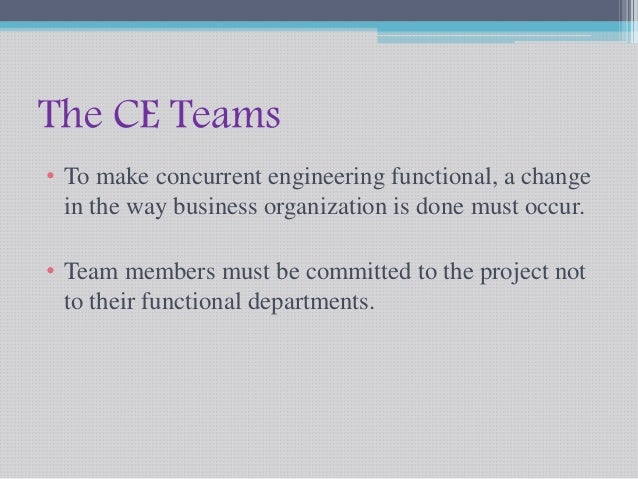Advantages Of Concurrent Engineering
What are the advantage of computer software How many mathematicians would it take to hand compute the Moon travel and landing? Many, many; they postulate that a crew of 200 mathematicians cranking that out would have taken a few lifetimes to accomplish. And once they completed it how many time s to verify and check sum the derived answer? Software gives us the opportunity to instruct computers to do relatively difficult calculations quickly, relatively easy, and over and over again.
Repetition is the watchword here. My favorite example is code for running a scientific function calculator. Once it is written it can be used by thousands of end users to do scientific calculations. Was it costly to produce that code relatively no. Is it cost effective to the user, yes. Does it speed up processing time for complex math yes. Ask any College student if they like their calculator?
Some of the competitive advantages of concurrent engineering include: All of the others The emphasis can be on problem resolution instead of conflict resolution. 18 December 2018. Prezi Awards 2018: The best presentations have arrived; 5 December 2018. Do this, not that: Keynote speech; 28 November 2018. Enhance your Prezi presentations with 500,000+ new images and icons. Realizing maximum benefits with the implementation of the concurrent engineering in new product design and development. The research further recommends that companies must focus on weak areas of design and development in order to enhance the productivity.
Does the code have to be maintained NOT MUCH after the initial bugs are worked out. The question is; do you expect someone to write all that code, in some software packages equaling millions of lines of code, for free? The return on your investment for software is relative to both to the complexity of the task it accomplishes and time saving return on investment in purchasing and utilizing the software.
(Example a spreadsheet passing values to several accounts) My favorite software is my email client that brings emails from friends relatives and business associates from around the world, I would not relish doing all that communication the old way. Pen and Pencil and Stamps and Envelopes and mailing or Pony Express. Your favorite software might be the browser that brings your Facebook page to your laptop.
Concurrent Engineering Techniques
There is an investment for the producer of software; time, effort, and hardware to bring you all the bells and whistles you demand to your desktop. Software allows end users to store, calculate, append, sort, file, share, delete and manipulate a myriad of data for the users delight, satisfaction, growth, aid, and results.
Without computer software you are unable to share photos, do video connections, broadcast college classes online, email, tweet, or find ancestors in world wide databases. Software is now helping to even drive your car. Waterfall model tends to consume a lot more time compared to other software development models though it is able to pinpoint definite starting and ending points for a given project. This model assumes the requirements to remain static during the life of the project, so there is little or no chance of incorporating new changes to the software once work begins. If changes are tried to be incorporated it leads to more confusion and further delays. Its strong points lie in the fact that it is sequential, so there would be no confusion on the steps and the processes are straight down-no need to worry about so many conditions while working on a project. Additionally, this type of model tends to pack up on so much documentation.
Therefore, such tends to be useful for future code revisions and reference. However, its drawbacks become apparent in the length of time a project will be developed and the cost it is able to consume.
During the industrial revolution, technology became more complex. The complexity forced forced employees of companies to specialize in different areas of the product design process.
No longer could one person be responsible for the design, manufacture and sales of a product. The era of the craftsmen gave way to the era of the specialist.
Large companies begon to organize their into departments with different responsibilities. Some examples of departments and responsibilities are shown below. Marketing – Tries to understand the future needs of the customer.
Design For Manufacture

Research – Develops the technology to meet the needs identified by Marketing. Design -Uses the technology developed by Research to design products to mee the needs of the customer. Manufacturing – Devlops the methods to manufacture the products designed by the desing department. Sales – Develop plans and executes the plans to sell the products to the customer. The design process was then organized into a linear system as shown in Figure 1. The “over-the-wall” design process. Each deparment worked on a product until they had completed their tasks and then they handed off the project to the next department.
Not only was this serial process very slow but it also caused many problems when the communication between departments broke down. The breakdown of communications led to projects being thrown back over the walls that divided the departments for rework. This reverse flow of projects is shown in Figure 2. The “over-the-wall” design process with reverse flow. Some typical reasons for reverse flow are listed below:.
Marketing specifies a need that research can not develop a technology to meet. Research develops a technology that is too expensive or not robust enough to use in a product. Design creates a design that in very difficullt and expensive to manufacture. After many changes to meet the demands of each department manufacturing produces a product that does not solve the customer’s problem or is to expensive. The concurrent engineerinng design process was developed to adress these problems.